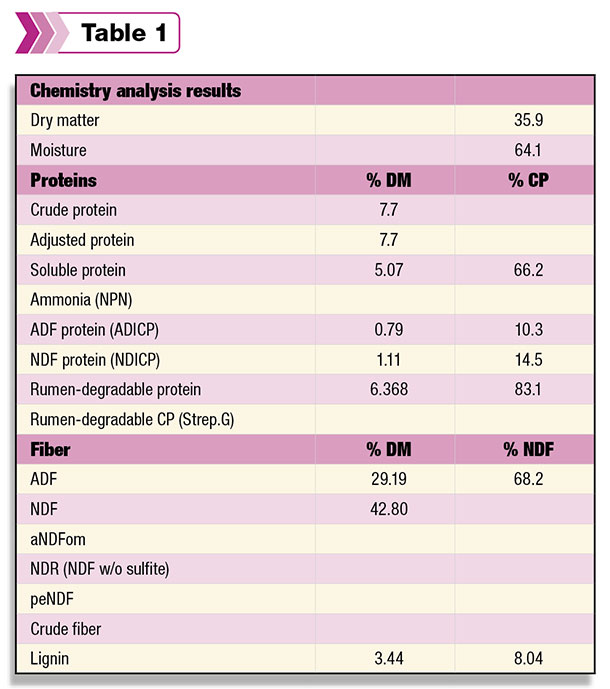Dry matter (DM) is what remains when water (moisture) is removed from a feed. In the example corn silage report (Table 1), you’ll see DM is listed at 35.9 percent. (For simplicity, we’ll round to 36 percent DM.) Another way to think about the concept of DM is: For every 100 pounds of this corn silage that is fed, 64 pounds of it is water.
 Knowing the DM of a feedstuff is important for a number of reasons, including:
Knowing the DM of a feedstuff is important for a number of reasons, including:
-
Buying forages – When purchasing feeds, we don’t want to pay for excess water.
-
Ensiling forages – Ensuring proper moisture of forage at the time of ensiling is critical to putting up a quality product.
-
Making hay – We want to minimize mold growth and heating.
-
Comparing feedstuffs – It’s imperative we compare the composition (nutrient and energy) of different feedstuffs on a DM basis. Basically, the DM basis puts everything on an equal basis for comparison.
-
Formulating rations – Water is an essential nutrient, but water does not contain energy, which is required to make milk. (You’ll notice in the report that the components are all reported on a percentage DM basis.)
- Mixing rations and feeding the herd – This will be the focus of the rest of this article.
As a feeder or a dairy producer, why is it so important to understand DM and measure it correctly? Because while it’s very important to provide cows with clean, readily accessible water, in terms of feeding cows, water does not contain energy – and energy is essential for milk production.
Let’s look at an example: Your nutritionist formulates a ration that calls for 6,000 pounds of as-fed corn silage to be added to the mixer wagon. The last DM analysis shows the corn is 36 percent DM (or 64 percent moisture). How many pounds of DM is that?
6,000 pounds x 0.36 DM = 2,160 pounds DM
What if the corn silage is now wetter than the original silage sampled, so the DM is actually 30 percent DM (or 70 percent moisture)?
6,000 pounds x 0.30 DM = 1,800 pounds DM
Because we didn’t correct the DM, we’ve cheated that particular ration of 360 pounds of DM from corn silage. At 30 percent DM, the amount of silage going into the mixer wagon should have been:
2,160 pounds DM ÷ 0.30 DM = 7,200 pounds of as-fed corn silage
In simple terms, because we shorted the mixer wagon of corn silage DM, the ration is no longer balanced for the nutrient and energy needs of the milk cows. If the ration is shorted 360 pounds DM of corn silage, there is less crude protein (CP) than formulated.
Basically, you thought you were adding 166.3 pounds CP (2,160 pounds DM x 0.077 CP) but only added 138.6 pounds CP (1,800 pounds DM x 0.077 CP). There is also less energy fed than formulated. These differences, over some time, might impact milk yield and even body condition and reproduction.
Troubleshooting DM results
Sometimes a DM result just doesn’t make sense with what you see at the silage structure or with a previous DM determination. This can happen with on-farm methods as well as samples sent to a commercial lab. Here are a few areas to troubleshoot when presented with inaccurate DM results:
1. Do you have a good sample?
Is your sample representative of what you’ll be feeding? Be sure to take multiple grab samples of the silage. Mix these grab samples in a bucket and then subsample to analyze for DM.
Do not take the samples directly from the structure face; instead, remove the forage from the face (with a front-end loader, for example), move a safe distance from the face and sample the removed forage. It’s best to do this with forage freshly removed from the face.
How was your sample handled? If the sample is not analyzed right away, store your sample in a cool, dry place. Carry an ice chest or refrigerate your sample to store for later use.
2. Is your scale working properly?
Check the batteries, and consider buying an inexpensive calibration weight kit.
3. When in doubt – compare.
Split your sample and run DM multiple times to see if your results are in agreement.
4. Train, train and re-train.
Having a written protocol for sampling, storing and analyzing DM on-farm is important to obtain accurate results. Check in on the person responsible for measuring DM to be sure he or she understands the protocol, has properly working equipment and doesn’t have any questions or concerns.
Current California methods
In a 2013 California survey, most dairies were checking the DM of corn silage one to three times per month (58 percent of respondents). About 28 percent of dairies checked the DM one to three times per week, with the remaining 14 percent of dairies measuring DM one to six times per year.
Half the dairies checked the DM on-farm, and the other half sent samples to a commercial lab for DM analysis. The most popular on-farm method was the Koster tester (76 percent), with fewer dairies using a microwave method (21 percent).
Dry matter is an important measurement. Wet feedstuffs, like silages, are likely to fluctuate in DM content and should be checked regularly.
Number of cows fed, structure size, past history, etc., will all dictate how often to sample for DM. Talk with your nutritionist to set up a sampling schedule for DM determination on your farm. PD
Ed DePeters is a professor with the University of California Department of Animal Science.

-
Jennifer Heguy
- Dairy Farm Adviser
- University of California Cooperative Extension
- Email Jennifer Heguy






